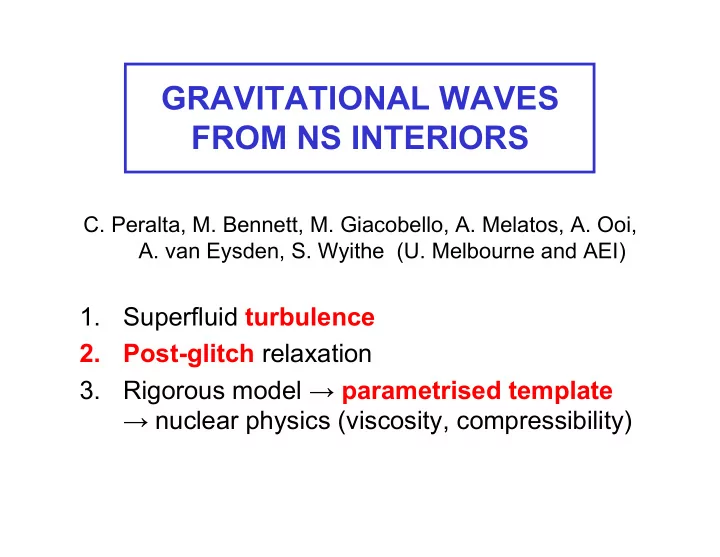

GRAVITATIONAL WAVES FROM NS INTERIORS C. Peralta, M. Bennett, M. Giacobello, A. Melatos, A. Ooi, A. van Eysden, S. Wyithe (U. Melbourne and AEI) 1. Superfluid turbulence 2. Post-glitch relaxation 3. Rigorous model → parametrised template → nuclear physics (viscosity, compressibility)
CONTINUOUS SOURCE C-C diff. rotation (glitches) → nonaxisymmetric superfluid flows Long-lived (days → years) periodic signal • Superfluid turbulence as pulsar spins down ( Re ≈ 10 11 ) • Post-glitch relaxation (Ekman pumping) • Follows burst signal of glitch itself (msec?) Not discussed here... • R-modes continuously excited in core (Andersson et al. 99; Nayyar & Owen 06) ; cf. ocean r-modes (Heyl 04) • Amplitude and threshold probe superfluid core and viscous crust-core boundary layer (Lindblom & Mendell 99; Bildsten & Ushomirsky 00; Levin & Ushomirsky 01)
SUPERFLUID CIRCULATION oscillating hydro torque EKMAN PUMPING Re =10 4 (Peralta et al. 05, 06, 07) Differential rotation → meridional circulation • superfluid → HVBK two-fluid model (3D) • Quantised vortices ↔ mutual friction
MACRO SF TURBULENCE TAYLOR VORTEX HERRINGBONE & SPIRAL TURBULENCE
POST-GLITCH RELAXATION • Ekman: fluid spun up in radially expanding boundary layer (meridional → Coriolis) • T Ekman = (2 E 1/2 Ω ) −1 with E = ν (2 Ω R 2 ) −1 ≈ Re −1 • Buoyancy inhibits meridional flow less/more according to compressibility K −2 − K −2 ) • Brunt-Vaisala frequency: N 2 =g 2 ( c eq • Incompressible: K → ∞ . Unstratified: N → 0 • Nonaxisymmetric perturbation ∝ exp( im φ ) • Wave strain : (van Eysden & Melatos 07, Bennett & Melatos 07)
GW SPECTRUM • Lorentzian: measure width & peak frequency 2 2 f f = = ( ) ( ) h f h f × + ω + − Ω 2 2 ω + − Ω 2 2 ( ) ( 2 ) E f E f 11 21 EQUATORIAL OBSERVER • Extract two of E, N, K if Ω known (X-rays) • Width ratio independent of E (i.e. viscosity) • Amplitude depends on distance, orientation, ∆Ω , and compressibilities… but not E • Pol’n ratio: orientation to line of sight (also N, K ) (van Eysden & Melatos 07, Bennett & Melatos 07)
(van Eysden & Melatos 07) K = 0.1 Ν = 1 K = 0.3 h + ( f ) K = 1 K = 3 f N = 0.1 K = 1 h × ( f ) N = 0.3 N = 3 N = 1 f
EXTRACTING NUCLEAR PHYSICS (Bennett & Melatos 07) E K N i i i E E K N K N Total signal including current quadrupole
PHYSICS TO WORRY ABOUT • Microscopic turbulence • DGI → tangle of quantized vortices • Affects the mutual friction coupling ↓ (Peralta et al 05, 06; Andersson et al 06, 07) • Macroscopic turbulence (Kolmogorov “eddies”) • Do large or small eddies dominate the GW signal?
WHAT WILL LIGO TEACH US? SF turbulence • Is the core superfluid? • Mutual friction & entrainment parameter • Viscosity • Crust-core coupling
Glitches • Measure c eq and K for nuclear matter • Do glitches happen faster or slower than one rotation period? • Probe “seismic” (avalanche) dynamics • Spectrum of non-axisymmetric excitation NO OTHER GOOD WAY TO LEARN SUCH THINGS!
Recommend
More recommend